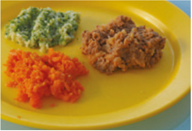
IDDSI is the International Dysphagia Diet Standardisation Initiative.
Why is this food texture needed?
It can be recommended for people who may have difficulties biting off pieces of food, chewing and swallowing but have some basic or beginner chewing ability. Some people may be able to bite off a large piece of food but may not be able to chew it down into little pieces that are safe to swallow. You only need a small amount of chewing to break down this texture for safe swallowing. It is important that Minced & Moist foods are not too sticky because this can cause the food to stick to the cheeks, teeth, roof of the mouth or in the throat.
What is minced & moist food?
- It is soft and moist but with no liquid leaking or dripping from the food.
- Food has been mashed or minced before serving.
- Biting is not required.
- It has lumps 4mm in size which is about the gap between the prongs of a fork.
- Lumps can be mashed with the tongue. It needs minimal chewing.
- Food can be easily mashed with just a little pressure from a fork.
- Holds its shape on a spoon but falls easily if the spoon is tilted or lightly flicked.
These aren't appropriate
- Lumps should not be firm.
- It does not need biting.
- No mixed (thick - thin) textures for example cereal in milk, mince in gravy, and dried fruit in sponge.



Food examples
Meat / fish
- Must be finely minced or chopped to 4mm lump size for adults.
- Serve in a thick, smooth, non-pouring sauce or gravy.
- If it cannot be finely minced, it should be puréed.
Fruit
- Serve finely mashed or use a blender to finely chop it to 4mm lump size pieces.
- Drain any excess liquid that has separated.
Vegetables
- Must be cooked.
- Must be finely mashed or use a blender to finely chop it to 4mm lump size pieces.
- Drain any excess liquid that has separated.
Cereal
- Served thick with small soft 4mm lumps.
- Any milk/ fluid should not separate from the cereal.
- Drain any excess liquid before serving.
Rice
- Requires a sauce to moisten it and hold it together.
- Rice should not be sticky or gluey and should not separate into individual grains when cooked and served.
- May require a thick, smooth, non-pouring sauce to moisten and hold the rice together
Dessert
- The texture of very thick, smooth yoghurt or stewed apple in very thick custard. Any lumps must be up to 4mm in size.
- Or the texture of soft sponge cake with smooth filling, fully softened by mashing and mixing in with very thick, smooth custard.
- No ice-cream or jelly if a person requires thickened fluids (because these can change to thin fluid in the mouth).
No regular dry bread due to high choking risk.
Meal ideas
Foods to avoid
Mixed thin and thick textures to avoid
Soup with pieces of food, cereal with milk
Hard or dry foods to avoid
Nuts, raw vegetables (e.g. carrot, cauliflower, broccoli), dry cakes, bread, dry cereal
Tough or fibrous foods to avoid
Steak, pineapple
Chewy or sticky foods to avoid
Lollies / candies / sweets, cheese chunks, marshmallows, chewing gum, sticky mashed potato, dried fruits, sticky foods
Crispy foods to avoid
Crackling, crisp bacon, cornflakes
Crunchy foods to avoid
Raw carrot, raw apple, popcorn
Sharp or spiky foods to avoid
Corn chips and crisps
Crumbly bits to avoid
Dry cake crumble, dry biscuits
Pips and seeds to avoid
Apple seeds, pumpkin seeds, white of an orange
Food with skins or outer shell to avoid
Peas, grapes, chicken skin, salmon skin, sausage skin
Foods with husks to avoid
Corn, shredded wheat, bran
Bone or gristle to avoid
Chicken bones, fish bones, other bones, meat with gristle
Round, long shaped foods to avoid
Sausage, grape
Sticky or gummy foods to avoid
Nut butter; overcooked oatmeal / porridge, edible gelatin, sticky rice cakes
Stringy foods to avoid
Beans, rhubarb
Crust formed during cooking to avoid
Crust or skin that forms on food during cooking or after heating, for example, cheese topping, mashed potato
‘Floppy’ foods to avoid
Lettuce, cucumber, baby spinach leaves
‘Juicy’ foods to avoid
Where juice separates from the food piece in the mouth; for example, watermelon
Large or hard lumps to avoid
Casserole pieces larger than 4mmx4mm; fruit, vegetable, meat or other food pieces larger than 4mmx4mm.
Useful resources
- The Caroline Walker Trust (opens in a new tab) for information and guidance to encourage eating well.
- Wiltshire Farm Foods (opens in a new tab)for ready prepared, frozen Minced & Moist texture meals that can be delivered to your home
- It’s made for you for ready prepared frozen Minced & Moist texture meals that can be delivered to your home.
If you have any questions please speak to your speech and language therapist directly or contact the Speech and Language Therapy Department on 01223 216200.
References / sources of evidence
© The International Dysphagia Diet Standardisation Initiative 2019 @ The IDDSI framework (opens in a new tab). Licensed under the Creative Commons Attribution-ShareAlike 4.0 License.
We are smoke-free
Smoking is not allowed anywhere on the hospital campus. For advice and support in quitting, contact your GP or the free NHS stop smoking helpline on 0800 169 0 169.
Other formats
Help accessing this information in other formats is available. To find out more about the services we provide, please visit our patient information help page (see link below) or telephone 01223 256998. www.cuh.nhs.uk/contact-us/accessible-information/
Contact us
Cambridge University Hospitals
NHS Foundation Trust
Hills Road, Cambridge
CB2 0QQ
Telephone +44 (0)1223 245151
https://www.cuh.nhs.uk/contact-us/contact-enquiries/

